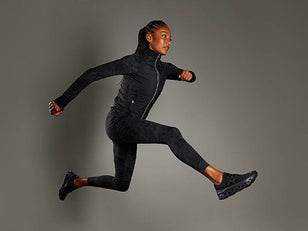
- MYTH: cellulite is unhealthy.
- FACT: 80-90% of adult women of all shapes and sizes, and ethnicities have cellulite (1).
What is cellulite?
Cellulite not a pathological condition, it’s physiological, which means it’s not harmful nor is it “abnormal”. Nevertheless, it can affect body image and quality of life.
Despite a huge interest (and even bigger market) in the treatment of cellulite, very little research has been done in this area. The limited research that has been done refers to cellulite as an aesthetic condition which can be characterised by an "orange peel" or “cottage-cheese-like appearance” (their words not mine) of the skin. It can affect any part of the body with subcutaneous adipose tissue (a.k.a. fat tissue) but mostly affects the lower body (e.g. bum and thighs). The classic dimpling is caused by fat tissue pushing through overlying connective tissue which leads to the classic orange peel appearance. Adding tension by pinching the skin or muscle contraction through movement can worsen their appearance (which is why you don’t really see cellulite when you lie down).
What causes cellulite?
The actual cause of cellulite is poorly understood, although certain factors increase the chances of you developing it, including sex, genetic predisposition, and lifestyle factors. Many over-the-counter anti-cellulite products claim to reduce cellulite by helping to eliminate toxins from the body, but this is a false claim which is not supported by science. Essentially it is not really your fault if you have cellulite and it’s likely that you got it from your mama and your grandmama - And yes, men get it too but women are more likely to get it due to our fat distribution and hormone profile.
Can I get rid of cellulite?
Even if I have convinced you that you don’t need to be worried, you may still want to reduce it. I get that. It’s hard not to want to have a smooth derrière when that’s all that we are exposed to in glossy magazines and on instagram (even if it has been photoshopped out 99% of the time).
The thing is, despite the array of therapeutic options that exist to treat cellulite, none of them have been proven successful in the long term (2). Anti-cellulite creams, injectables, fillers and laser may help to reduce the appearance of cellulite temporarily, but they cannot “cure” it as that would involve physically changing the tissue structure (2). A 2015 review of a variety of studies into the effectiveness of different techniques indicated that either the treatments were not very effective, or the research methodology was flawed (3). Now, this does not mean all treatments are completely useless but any treatment promising elimination of cellulite should be approached with caution and a healthy dose of skepticism.

What about “cellulite-targeting” exercises?
I also often get asked if I there is a workout to help spot-reduce cellulite, and while exercise can help build muscle and reduce body fat - thereby improving the appearance of cellulite, it cannot get rid of it completely. The concept of spot-reducing body fat is also flawed as you can’t choose what parts of your body you lose fat from. The thing to remember is exercise should not just be viewed as a method for changing our appearance, be that weight loss or cellulite reduction, as it has an array of benefits to offer us.
Research shows that exercise can improve body image (including body appreciation, internal body orientation, and functional body satisfaction), however this effect is weakened if people are highly motivated by appearance-based reasons for exercise (i.e. weight loss) (4). On the flip side,
focusing on body functionality (i.e. what we can do) rather than how we look, has been linked to positive body image (5)
This is why I celebrate campaigns such as “This Girl Can” that share images of women doing sport help move the focus away from how our bodies look, to what our bodies can do. Thankfully we are also seeing more and more online retailers choose not to photoshop out cellulite or stretch marks or any other parts of our bodies previously deemed “imperfect”. Our bodies are supposed to be different, they’re supposed to move and jiggle when we move and jiggle, and having scars, stretchmarks, and cellulite are not something we should stigmatise or create shame around.
The bottom line.
I hope you read this article and feel inspired - but I understand that for some people it may not have offered your the answers you were looking for. How we feel about our bodies is ever-changing, it changes as we go through our life cycle and it even changes on a daily basis. So it’s okay to sometimes feel in a bit of a funk with your body image some of the time but hopefully this article will act as a little reminder that:
- a) Most of us women have cellulite.
- b) It does not mean you are unhealthy or unfit.
- c) Focusing on what your body can do, and not how it looks, can support both your mental and physical health.
For more scientifically-backed nutritional and lifestyle insights, follow @thefoodmedic on instagram
Next up:
Are you dehydrated? 5 causes for concern >
References:
- Emanuele E. Cellulite: advances in treatment: facts and controversies. Clin Dermatol. 2013;31(6):725–730.
- Sadick, N., 2018. Treatment for cellulite. International journal of women's dermatology.
- Luebberding, S., Krueger, N. and Sadick, N.S., 2015. Cellulite: an evidence-based review. American journal of clinical dermatology, 16(4), pp.243-256
- Homan, K. J., & Tylka, T. L. (2014). Appearance-based exercise motivation moderates the relationship between exercise frequency and positive body image. Body Image, 11, 101–108. http://dx.doi.org/10.1016/j.bodyim.2014.01.003
- Wasylkiw, L., & Butler, N. A. (2013). Body talk among undergraduate women: Why conversations about exercise and weight loss differentially predict body appreciation. Journal of Health Psychology, 19(8), 1013–1024.doi:10.1177/1359105313483155






























































